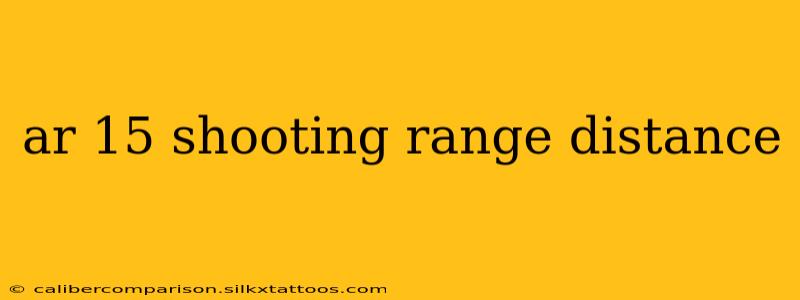The question of optimal shooting range distance for an AR-15 is multifaceted, depending heavily on the specific purpose, the shooter's skill level, and the type of ammunition used. There's no single "best" distance; instead, understanding the capabilities of the AR-15 platform and responsible firearm handling practices will guide your decision.
Understanding AR-15 Ballistics
Before delving into ideal distances, let's briefly touch upon the ballistic characteristics that influence effective range. AR-15s, chambered in 5.56 NATO/.223 Remington, are intermediate-caliber rifles. This means their bullets have a balance between velocity and stopping power, offering a relatively flat trajectory compared to larger calibers but less range than longer-range cartridges. Bullet weight, type (full metal jacket, hollow point, etc.), and even the specific rifle's barrel length will affect the projectile's trajectory and accuracy.
Common AR-15 Shooting Distances and Their Applications
Here's a breakdown of common shooting distances and their typical use cases:
25 Yards (22.9 meters):
- Ideal for: Zeroing the rifle, practicing basic marksmanship fundamentals (sight alignment, trigger control, breathing techniques), and familiarization drills. This close range allows for rapid target acquisition and helps develop consistent shooting habits.
50 Yards (45.7 meters):
- Ideal for: Refining accuracy, working on shot placement, and evaluating the rifle's zero at a slightly longer distance. At 50 yards, minor inconsistencies in technique become more apparent.
100 Yards (91.4 meters):
- Ideal for: Further accuracy refinement, testing ammunition consistency, and assessing the impact of environmental factors (wind, temperature). This range reveals more about the rifle's inherent accuracy and the shooter's ability to compensate for external influences.
Beyond 100 Yards:
- Ideal for: Advanced marksmanship training, long-range shooting competitions, or specific scenarios where longer-range accuracy is crucial (though less common for standard AR-15s). At these distances, specialized ammunition, optics, and advanced shooting techniques become essential. Consistent accuracy becomes significantly more challenging due to bullet drop and wind drift.
Factors Influencing Optimal Distance
Several factors must be considered beyond just the inherent capabilities of the AR-15 platform:
- Shooter Experience: Beginners should focus on shorter ranges to build foundational skills before progressing to longer distances.
- Ammunition Type: Different ammunition types will exhibit varied ballistic performances, influencing the optimal effective range.
- Optics: The magnification and quality of your scope or sights will significantly impact your accuracy at longer distances.
- Environmental Conditions: Wind, temperature, and humidity will all affect bullet trajectory, making longer-range shooting more challenging in less-than-ideal conditions.
- Target Type: The size and type of target will determine the appropriate distance for effective engagement.
Safety First: Always Practice Responsible Gun Handling
Regardless of the shooting distance, responsible gun handling is paramount. Always follow all safety rules at the shooting range, including:
- Never point a firearm at anything you do not intend to shoot.
- Keep your finger off the trigger until ready to fire.
- Always be sure of your target and what is beyond it.
- Wear appropriate eye and ear protection.
- Follow all range rules and instructions.
By understanding the capabilities of your AR-15, considering the factors mentioned above, and prioritizing safety, you can determine the most appropriate and effective shooting range distance for your skill level and objectives. Remember, consistent practice at various distances is key to improving your marksmanship.

